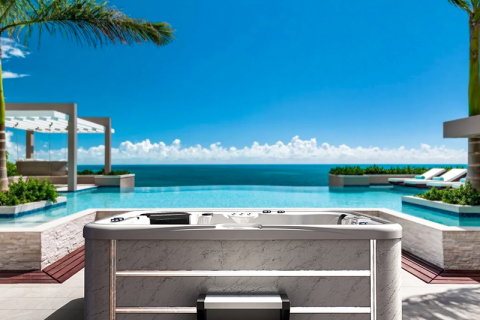
- Home
- >
News
Hot tubs can burn a small amount of calories, but if you want to lose weight you still need to exercise moderately and eat a healthy diet.
The water temperature of most outdoor hot bathtubs can be adjusted according to the needs of users, and the general temperature range is between 37°C and 40°C (98°F to 104°F). But it should be noted that this does not mean that everyone is suitable for bathing in this temperature range.
while the jets can speed up the circulation of water to some extent, their effect on raising the water temperature is not obvious, and in some cases, it may even extend the heating time.
Hot tub disease (Hot Tub Lung), also known as "hot tub lung disease", refers to a lung disease caused by specific microbial infection or allergic reaction of the human respiratory system after inhaling water vapor or aerosol in a hot bathtub. It is a rare but real respiratory disease that is mainly related to a bacterial infection called "nontuberculous mycobacteria" (NTM).
If the air in the pump and pipes is difficult to exhaust, you can try to tilt the outdoor hot bathtub appropriately to allow the air to concentrate at one end of the pipe before exhausting.
When air humidity is low, water evaporates faster. When the air already contains less water vapor, water evaporates faster into the air. Therefore, in dry summers, especially in areas with dry climates, water in an outdoor hot bathtub evaporates more easily.
Generally, the chlorine concentration in the outdoor hot bathtub should be kept between 3 and 5 ppm (parts per million). Higher concentrations may be harmful to the human body. If a high dose of chlorine is used during shock treatment, the waiting time may need to be extended, even to several hours.
The water temperature of outdoor hot bathtubs is usually higher, usually maintained at around 37°C to 40°C. While these temperatures are ideal for relaxation and muscle tension relief, they are also ideal for the growth of certain bacteria and microorganisms.
The balance of chemicals is very important for the water quality of the outdoor hot bathtub. If the concentration of chemicals in the water is too high, especially when it comes to foaming agents and lubricants, the water will produce more foam under the impact of the strong water flow of the jet.
After a day of work and life pressure, the night is the time for most people to relax. The outdoor hot tub itself can help relax muscles and soothe tense nerves through hot water and massage functions, and the quietness and privacy of the night make this relaxation effect more significant.
The heating system in a hot tub is controllable, meaning that the user can turn it off as needed. On hot summer days, it is perfectly acceptable to turn off the heating system and keep the water in the tub at natural ambient temperature.
Alkalinity refers to the concentration of bicarbonate ions (HCO₃⁻) in water. Alkalinity not only affects the degree of pH fluctuation, but can also directly cause pH to rise. If the alkalinity in your outdoor hot tub is too high, the water's buffering capacity will increase, which will resist the drop in pH and cause the pH to gradually rise.












